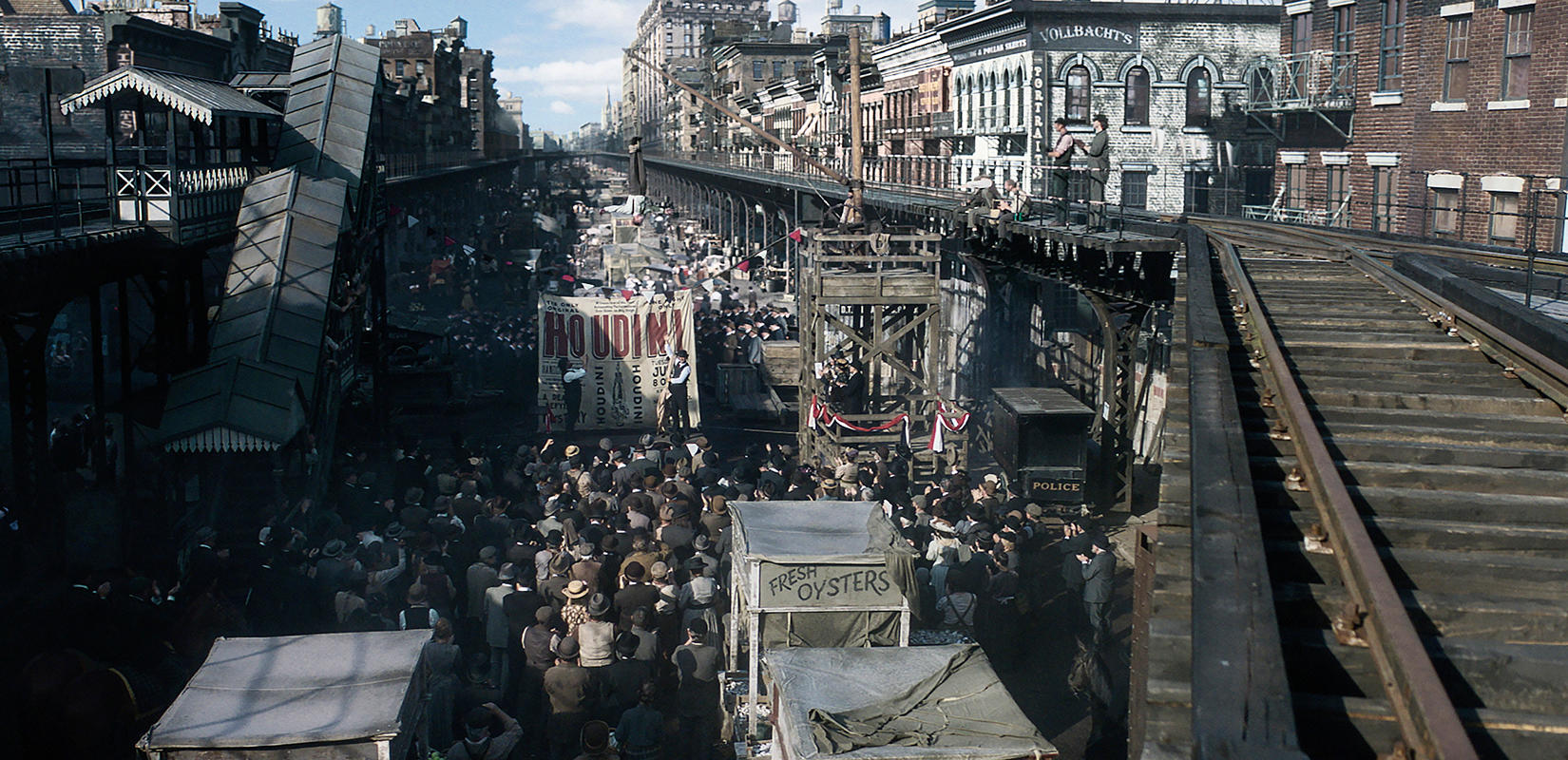If you are like us, you have been diligently watching new episodes of TNT’s drama The Alienist every Sunday night and getting giddy over how the show masterfully recreates 1890’s New York City. The second season of this historical crime drama, titled “Angel of Darkness,” follows alienist Dr. Lazlo Kreitzler (Daniel Brühl), private detective Sara Howard (Dakota Fanning), and New York Times reporter John Moore (Luke Evans) as they seek to solve a case of kidnapping and murder. Lucky for us viewers, the investigation takes the show’s characters from the most glittering of Gilded Age mansions to the grimiest downtown streets. One of the most noteworthy locations we’ve seen so far is Manhattan’s long lost Gansevoort Market. Untapped New York spoke to Production Designer Ruth Ammon, who gave us a step-by-step guide to how she and the production team recreate historic New York City sites in present-day Budapest. Don’t worry, no spoilers!
In episode two, “Something Wicked,” Fanning and Evans’ characters find themselves on the seedy side of town, along the west side piers, tracking down a ruffian named Goo Goo Knox, leader of The Dusters. Knox and The Dusters are characters plucked off the real-life streets of 1890s New York. Francis “Goo Goo” Knox was a leader of The Hudson Dusters, one of the many street gangs, including the Gophers and the Potashes that crawled the alleyways of Hell’s Kitchen, Greenwich Village, and the Meatpacking District.
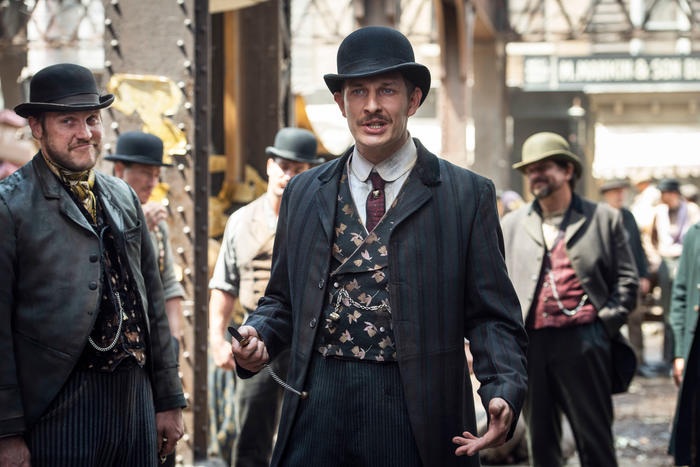 Goo Goo Knox played by Frederick Schmidt, Photo by Kata Vermes / TNT
Goo Goo Knox played by Frederick Schmidt, Photo by Kata Vermes / TNT
Moore and Howard’s run-in with Goo Goo takes place in the crowded alleys of the Gansevoort Market. This open-air municipal market, known originally as Farmers’ Market, opened in 1879 at Gansevoort and Washington Streets on the former site of a Hudson River Railroad train yard. A military fort previously occupied the site. By the late-19th century, the area surrounding the market was a bustling industrial and commercial district bounded by the Gansevoort-Chelsea Piers and the elevated railway along 9th Avenue.
There were lumber yards, ironworks, and paint factories, and food vendors clogged the streets. There were also slaughterhouses and meatpacking plants for which the district would eventually be named as the meat industry became more predominant over time. Gansevoort Market was mainly a produce market where farmers from the country would bring their wares. Business at Gansevoort Market, mainly the selling of wholesale produce, fruit, dairy products, specialty foods, and liquor, flourished for decades amid the crime and grime of its industrial setting.
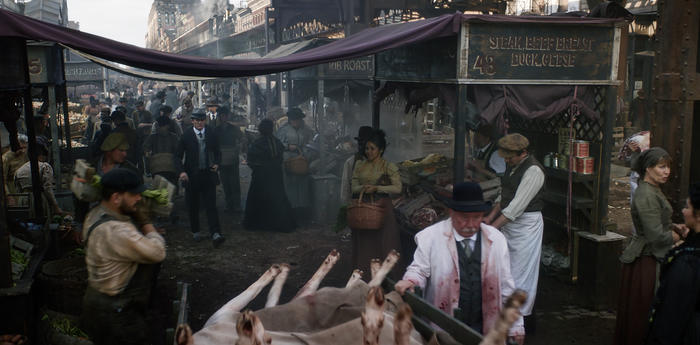 Photo by Kata Vermes / TNT
Photo by Kata Vermes / TNT
By the mid-20th-century, the space available to Gansevoort Market had diminished. Part of the land was taken by the New York Central Railroad and vendors were moving to other parts of Manhattan or the outer boroughs. The open-air market was finally replaced by a meat processing plant in 1939.
Below, production designer Ruth Ammon shares her sources of inspiration and explains how she and her team brought Gansevoort Market, and other lost New York City sites, back to life for The Alienist:
Untapped: We caught some great inspiration sources for a few things: Bandit’s Roost photograph by Jacob Riis for one of the alleyways, and one archway of the entrance of the department store that’s now Bed Bath and Beyond on Sixth Avenue. What sources did you use for inspiration for the Gansevoort Market and the pier?
Ruth Ammon: Good eye! That is indeed the entrance to Bed Bath and Beyond at 620 6th Avenue between 18th and 19th streets. It is also the original site of New York City’s second department store, The Siegel-Cooper Department store (1887), a huge shopping emporium encompassing an entire block. It was the largest store in the world for a time. It was also famous for a grand fountain located in the center of the first-floor atrium where shoppers would meet. We recreated the fountain via VFX.
We physically designed and built around 100 feet of the ground floor exterior in our backlot. We were able to dress the massive windows with all the gorgeous goods that would have enticed the pedestrians walking along Ladies Mile, the nickname for that strip of 6th Avenue. Our set and 3-D models were seamlessly transitioned into the VFX extensions. We had to modify the entrance to match with a scene that was filmed as the interior location/entrance. The Siegel-Cooper building is a New York architectural gem, so finding great research was not difficult. There were some changes to the building through the years that our researcher Natasha Pearl found and shared with the visual effects department.
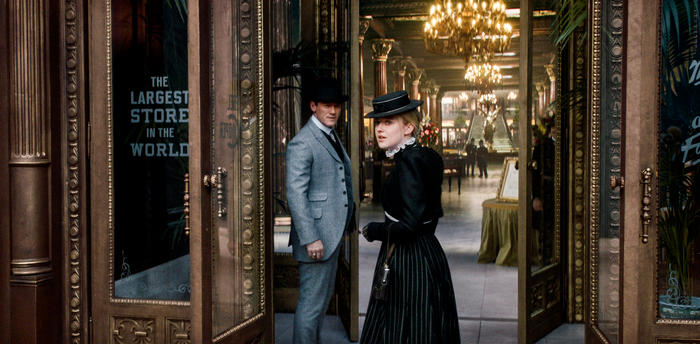 The entrance to Siegel-Cooper, Photo by Kata Vermes / TNT
The entrance to Siegel-Cooper, Photo by Kata Vermes / TNT
Coincidentally I had stopped in New York, my former home of twenty years, before heading to Budapest to collect some research and wander the streets. Though the department store was not in the script at that time, I had vigorously photographed the details of this Beaux-arts gem because I had always loved it. While in New York, I also had the treat of visiting the National Arts Club in Gramercy Park, The Met, of course, and Central Park.
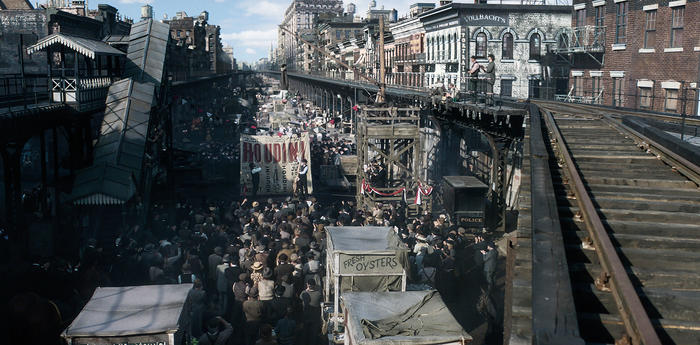 Photo by Kata Vermes / TNT
Photo by Kata Vermes / TNT
Gansevoort Market, the somewhat later offshoot of West Side Market, was created as more of an idea or memory than true historical geography. Part of the elevated train had been constructed in season one for the Bowery set. In season 2, we converted that set with major modifications hoping to create a dark and deep shadowed underbelly to the Gilded Age. I have always loved elevated train stations, and building one for season two was rewarding and had a great impact. We added buildings, specifically the meatpacking building, some of it taken from my memory living in New York, dining at Florent! The addition of the cross tracks to the railroad gave us more forced perspective expansion and great shadows. Building the meat and fish stalls created a more commercial zone that would connect the West Side Piers and Greenwich Village.
There is so much research on New York covering this period, you would need years to go through it all, and I would love it!
During the time, photographers like Jacob Riis were documenting everything. Jacob Riis was our Bible. With all the exploding growth of the city, people were documenting the great achievements. “New York 1880” by Stern, Mellins, and Fishman was on everyone’s desk in the Art Department. I also had a few of my beloved Dover books on Gilded Age interiors, carriages and wagons, and eating and drinking which had marvelous illustrations of food throughout the centuries. I used many books on painters (and a visit to the Met): John Singer Sergeant, William Merritt Chase, Whistler, Cecelia Beaux. I had lived in New York for 20 years, and every memory of walking those streets and avenues came back to me.
Untapped New York: For online research, Ammon said she used some of our favorite websites like Daytonian in Manhattan, Ephemeral New York, as well as 17th Street, a website dedicated to author Caleb Carr and his book series which the show is based on. She noted that NYC Architecture “was invaluable for everyone, especially all the international art directors and set designers who grew up in Europe or Los Angeles. They needed to understand the architecture of New York through the ages. What America looks like and the scale.” She also says she uses the Library of Congress for almost every project, and of course, the New York Public Library, “for everything.”
Here’s how Ammon describes the process of recreating a location from scratch:
- Read a script and decide what story we want to tell. We do this with the creative team, showrunner, director, and cinematographer.
- Research, photos, etchings, paintings, films that inspire setting, architecture, palette, and dressing; what creates the feeling we are going after.
- Put together a large visual presentation that covers all the major settings, critical scenes, and illustrations; the visual arc of the production.
- Rough sketches of the wide shot, a perspective sketch that implies the view. Work through pencil ground plan/maps with the design team. Art directors design in 3-D models, SketchUp for the initial presentation to Director and Cinematographer, make adjustments.
- Set designers draw the real construction plans with all the complex details and scale that give the building its truth. They are critical!
- Concept illustrations: These are color renders that incorporate the entire scene. We present to the entire creative team and head of departments the concept for the big establishing shot. What is the view beyond the created set? The population, male or female? Rough or tailored? What wagons or carriages would be appropriate? What about the atmosphere: smoke, fog, rain, snow? What are the street vendors selling?
- Time permitting, we have created a few sets in a gaming engine (Unity) that allows us, through the use of Oculus glasses, to “walk” through our virtual reality model. Set Designer Serban Rotariu built this for Gansevoort Market. We also created little movies from this VR model with our Cinematographer, Cathal Watters. He could choose a lens, move the camera, and storyboard the scene.
- Build mood boards with Set Decorator, Missy Parker. Missy and I have a long history together, so it’s like hanging out together and talking about all the details we love. This starts with deciding the visual elements that build the character; a color palette usually from a painting—shapes, and types of furnishings, drapes, wallpapers, and lighting. Missy brings the specific character to life, all the details that build a believable and meaningful set.
 Photo by Kata Vermes / TNT
Photo by Kata Vermes / TNT
- Meet with Lead Scenic painter to discuss paint finishes, colors, patinas, textures, aging.
- Meet with Graphic Designer. The sign work on a show of this scale is massively dense. We created the footprint for our sign writer to paint from. Signwriting is the original and the only way to create a true 19th-century feel. We were so lucky to have the sign-writing legend Roy Monk from London.
- Meet with prop master to discuss featured interactive props, for instance, the first electric chair at Sing Sing Prison, the bold, graphic, over-the-top Victorian food displays, or the replica of Marie Antoinette’s Belvedere Pavillion at Petite Trianon. Also, the cake seen in Episode 3 at the Hearst engagement party. Ellen Freund was a return craftsman from Season 1. Her knowledge and passion for the details of the 19th-century are brilliant.
- Meet with picture vehicles and animal wranglers to discuss what carriages we will use on what set and what specific type of horse and color of horse will be pulling.
Hope for the best on the day!
Untapped: Of course, we assume in some aspects you have to depart from historical accuracy for the sake of the set. Are there any examples like this you can mention that illustrate this?
Ruth Ammon: We always want to be accurate and work very hard to get it right. We do obsess, but I find sometimes the correct answer angles towards the story you want to tell. Most important for me, considering the scale and speed on which we operate, is the expression and soul of the story. When a Starbucks cup is left in the scene it’s dreadful.
As mentioned above we had to compromise the scale of the front entrance to Siegel Cooper Department store for the sake of practicality and to match an interior lobby scene filmed earlier. But I think it worked.
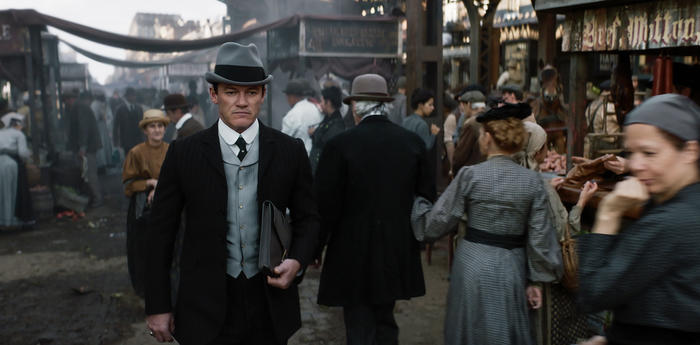 Photo by Kata Vermes / TNT
Photo by Kata Vermes / TNT
Untapped: What are some of the tools used to take a set from idea to execution?
Ruth Ammon: Beyond the technical drawings, we build 3-D Sketchup models that live on the computer but are available to share. We would project these onto the walls of our conference room for all to discuss. We also had a marvelous Hungarian team of model makers that build real models of every set. They were stunning! This was great for the director, cinematographer, and the assistant director team to plan their shots and their day. As mentioned above, when we could, we built Virtual Reality sets. This was the first time I was fortunate enough to experience that.
Untapped: What have been some of the challenges and plus sides of building a set from scratch in Budapest? We assume it was difficult to find old New York here in NYC these days!
Ruth Ammon: Ahhhhhhh, that may take a century to describe. So many highs and some real gut-wrenching lows. Budapest is a great city with many 19th-century Baroque-style buildings that worked well for the Gilded Age exteriors and interiors. The city has many stunning locations and interiors that are familiar to filmmakers everywhere. Hungary also has a well-established history in film making, so the craft and artistry is part of the culture. However, it is also a tourist destination for all of Europe, mostly young, single college kids. It’s fun, beautiful, has an interesting history, and is inexpensive. During the summer, it is alive with festivals of every nature that shut down streets and parks. As our production pushed into the summer, we had to make many compromises for which we hadn’t planned. During our tenure in Budapest, there were many other international productions that drained the available Hungarian work pool. We in the art department ended up with a very international team, Hungarian, American, German, British, Italian, Romanian, and Croatian, all who became great friends enjoying the fruits of Budapest on their time off and continuing into twenty member Zoom hangouts during COVID. No matter, these kinds of projects are a dream for us. There are always difficulties and problem-solving in multiple languages.
It was a great lesson; I would be happy to do all over again.
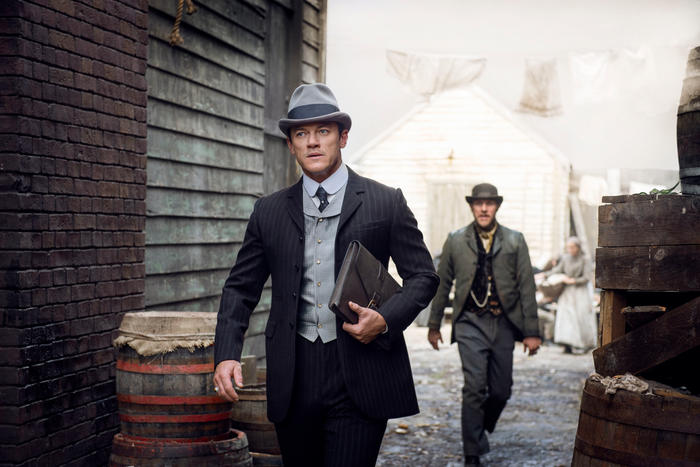 Photo by Kata Vermes / TNT
Photo by Kata Vermes / TNT
Not only does the show fabulously display the dress and decor of old New York, but it is also involved in the current day affairs of the city. On the show’s opening weekend, TNT partnered with local partner Feed the Frontlines NYC and famed restaurant Delmonico’s (a setting that features largely in both seasons and is one of New York’s oldest eating establishments) to bring prepared meals cooked by their executive chef to hundreds of New York City healthcare workers at Mount Sinai West, Manhattan VA Medical Center, and Bellevue Hospital. The three-course meals featured select items that have been on the menu since the 1890s like the classic BLT wedge salad, Delmonico’s steak, and rice pudding cake.
Want to wear a piece of the show? There is a curated line of clothing and accessories at Bergdorf Goodman inspired by the award-winning period costumes. The clothes take cues from the decadent dress of the Gilded Age as well as the dark underbelly streets and are fit for the fashionable, modern-day New Yorker.
You can see Ammon’s work in new episodes of The Alienist on TNT, Sunday nights at 9pm EST, or catch up on already aired episodes on TNT’s website.
Next, check out NYC Filming Locations Recreated for TNT’s “The Alienist” Season 1
Interview by Michelle Young, Reported by Nicole Saraniero






